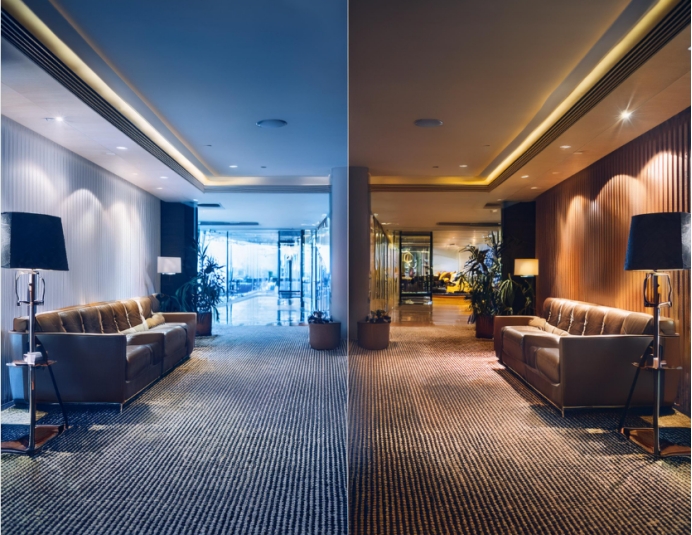- 14
- Aug
改造飯店大廳:現代白天和夜間照明解決方案| LEDER Lighting 高級照明設計師 Jane Smith 的專家見解
飯店大廳照明的現代方法
大廳照明設計的關鍵考量
以人為本的照明
適應現代酒店設計

- 協同設計流程
-
照明不足與客人舒適度
案例研究

- 案例研究1:
- 個案研究2:
- 案例研究3:
個案研究4:
-
個案研究5:

結論
-
大廳照明設計在塑造賓客體驗方面發揮著至關重要的作用。隨著酒店的發展,照明方法必須做出相應的調整。透過專注於以人為本的設計、與室內設計師合作以及滿足現代需求,飯店可以打造溫馨、實用、視覺震撼的大堂,給客人留下持久的印象。
設計貢獻此設計方法由LEDER Lighting 的高級照明設計師Jane Smith 領導。 Jane 在飯店照明設計領域擁有超過 15 年的經驗,專注於創造創新和實用的照明解決方案,在增強賓客體驗的同時符合當代設計趨勢。她在平衡美觀和實用性方面的專業知識確保酒店大廳不僅具有視覺吸引力,而且能夠滿足現代客人的需求。聯絡LEDER Lighting 的Jane Smith .
- Functional Integration: Beyond aesthetics, lighting must meet the functional needs of the lobby. This includes providing adequate illumination for reception areas, seating zones, and pathways while creating focal points and visual interest.
- Feedback and Refinement: Regular communication and feedback between designers help refine the lighting plan. Adjustments based on practical considerations and guest feedback ensure that the final design meets both visual and functional expectations.
-
Lighting Insufficiency and Guest Comfort
A critical aspect of lobby lighting design is ensuring adequate illumination to prevent discomfort caused by insufficient lighting. While poor lighting might not be immediately noticeable on cloudy days, transitioning from bright outdoor environments to poorly lit indoor spaces can become problematic.

Visual Discomfort: Guests may experience visual discomfort when moving from a well-lit outdoor area to a dimly lit lobby, leading to eye strain and negatively impacting their overall perception of the hotel.
Case Studies
- Case Study 1: A luxury hotel in Paris received complaints from guests about eye strain upon entering the lobby. The solution involved increasing overall lighting levels and incorporating transition lighting elements to ease the shift from outdoor to indoor environments.
- Case Study 2: A boutique hotel in New York faced similar lobby lighting insufficiency issues. The redesign included installing adjustable lighting systems and ambient fixtures to provide more comfortable and gradual light level changes.
- Case Study 3: A resort in Bali encountered the problem of guests feeling disoriented when transitioning from bright outdoor spaces to the lobby. The solution involved introducing a combination of indirect lighting and natural light sources to create a smoother transition.
- Case Study 4: A city hotel in Tokyo found that inadequate lobby lighting affected guests’ first impressions. The redesign focused on enhancing ambient and task lighting to ensure a warmer and visually comfortable environment.
- Case Study 5: A modern hotel in London was troubled by insufficient lobby lighting affecting guest comfort. The renovation included a layered lighting strategy and improved light sources to effectively address the issue.
Conclusion
Lobby lighting design plays a crucial role in shaping the guest experience. As hotels evolve, lighting approaches must adapt accordingly. By focusing on human-centric design, collaborating with interior designers, and accommodating modern needs, hotels can create lobbies that are welcoming, functional, and visually stunning, leaving a lasting impression on guests.
____________________________________________________________________________________________________________________
Design Contributions
This design approach was led by Jane Smith, Senior Lighting Designer at LEDER Lighting. With over 15 years of experience in hospitality lighting design, Jane specializes in creating innovative and functional lighting solutions that enhance the guest experience while aligning with contemporary design trends. Her expertise in balancing aesthetics and practicality ensures that hotel lobbies are not only visually appealing but also meet the needs of modern guests.
For more information or to discuss your hotel’s lighting needs, please contact Jane Smith at LEDER Lighting.
